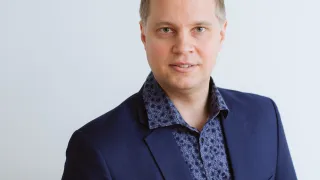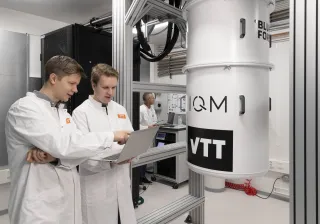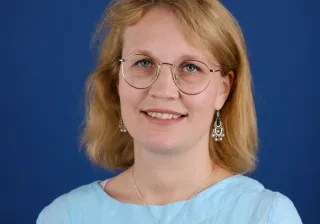At last, we succeeded in having our work published in one of the world's most highly esteemed scientific journals. And what is more, on quantum technology, a subject in which VTT and Finland aim to be global leaders. Achieved in collaboration between VTT and Aalto University, this breakthrough may also speed up the development of quantum computers that can solve real-word problems.
Let the photons shake
In the article, we demonstrated the world’s most accurate thermal radiation detector or bolometer. Based on the measurements, the estimated accuracy is so good that the bolometer should be able to detect individual microwave photons.
What is special in our bolometer is its astonishing speed. The bolometer is about hundred times faster than its predecessor.
Extreme accuracy, combined with fast operation, make the device interesting for the development of quantum technology. In the future, it could be used for reading the memory of a superconducting quantum computer or the signals of a quantum radar. Much remains to be studied.
Long road to success
The road to this breakthrough and the appearance on the pages of Nature started ten years ago when a patent application was filed on the subject. Raising the necessary funding and sharpening the tools took time. I needed to attract the right experts to my Quantum Computing and Devices group, whom I hired from places as diverse as Switzerland and the United States.
Some years ago, we already demonstrated in our laboratory at Aalto University the world’s most accurate bolometer with the lowest noise in the world. However, the result was not sufficient for boosting quantum technology.
We took an important step about four years ago when we switched from metal to atom-thin graphene to enable the detection of even smaller energies.
However, we also encountered problems. After promising test samples, only one of the actual bolometers worked, and only partly. The heater did not work. Additionally, the manufacturing of bolometers from individual graphene flakes was very slow, and we were about to lose our graphene wizard to the lure of the world’s top universities.
We thought of giving up. Maybe this was too challenging for us.
However, I encouraged my team to try to heat the bolometer along the wire intended for reading it. This makes it more difficult to determine the power heating the bolometer than by using the heater designed for it, but in theory, it is possible.
And it succeeded, after all. The graphene bolometer proved unprecedently accurate.
And it succeeded, after all. The graphene bolometer proved unprecedently accurate.

The corona pandemic hit in a surprising way
The article was almost ready when the corona pandemic arrived at the Otaniemi campus. Our Aalto laboratory had to be closed down and no-one from my research group was allowed to enter the building.
Three weeks later, I submitted the article to Nature for review. I thought that we’ll have to try even if it probably will not get accepted. At least this will give us the opportunity to live in hope in the midst of hopelessness. Like squeezing a lottery ticket in one’s hand awaiting results.
Maybe the corona pandemic had paralysed other research groups from sending out their papers. Maybe our work was simply really good. Nature took it up for review and accepted it without problems. We felt like a child drinking hot chocolate after having been rescued from icy water. We did it!
The work, of course, will not end here. We aim to use the bolometer in quantum technology, such as in reading quantum information. And this is only a small fraction of all the inventions we need in order for a quantum computer with useful everyday applications to see the light of the day.
Quantum technology will still need many other breakthroughs and sustained effort, which is something we are good at.
Quantum-technology breakthroughs stem from top expertise
Global investments in quantum technology are gaining momentum. Investments in the range of billions have been announced by at least China, the United States, EU, and Germany.
When I heard about the additional government budget for VTT for the purchase of a quantum computer and, consequently, for starting up a quantum ecosystem for the whole of Finland, I was touched. The decision-makers had understood the importance of the field and recognised the significance of this national spearhead project.
But do we stand a chance in this fight against windmills? Will millions freeze in the shadow of billions?
In my opinion, the recent publication is yet another proof of the local excellence. Quantum technology will still need many other breakthroughs and sustained effort, which is something we are good at. Copying from others will not lead to glory. But if we are not able to work together, we will lose. I think we must share knowledge and expertise, not sit on them. A common goal is, ultimately, to everyone’s benefit.
The direction of quantum technology is good in Finland, but keeping the course requires continuous effort and more talented workforce. Even though the work is strenuous, we must not give up. Otherwise the next breakthrough may well be trashed, as almost happened with our bolometer.
Sincere thanks to our colleagues
- Jukka Pekola taught low-temperature physics and prepared the first patent application with me.
- Joonas Govenius was my first doctoral student on bolometers, and he started the experimental work. Joonas currently works as the Leader of the Quantum Technology team at VTT.
- Russell Lake was my first post-doctoral researcher on bolometers, who to develop manufacturing and measuring methods. At present, Russell works at Bluefors.
- Roope Kokkoniemi wrote his doctoral thesis on bolometers, carrying out the most important measurements with a graphene bolometer. At present, Roope works at the quantum computer company IMQ.
- Jean-Philippe Girard carried out measurements and continues with the development of bolometers in my research group as a post-doctoral researcher.
- Pertti Hakonen with his team joined me in the effort to develop a graphene bolometer.
- Antti Laitinen was Pertti’s graduate student who manufactured the graphene components for the bolometer. At present, Antti works as a post-doctoral researcher at Harvard.
- Visa Vesterinen was a post-doctoral researcher in my group who wrote measurement and analysis code in particular. Employed by VTT, Visa presently works as a Group Leader at Quantum Technology Finland (QTF), a national Centre of Excellence funded by the Academy of Finland.
Many others who contributed to the different stages of this work and the development of quantum technology in general also deserve the warmest gratitude for their cooperation.




